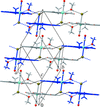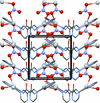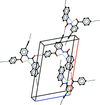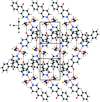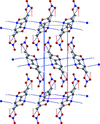issue contents
April 2017 issue

Cover illustration: Chalcone derivatives show a wide range of applications, especially in medicinal chemistry. This report describes the synthesis and crystal structure of a chalcone formed during the reaction between 4-(dimethylamino)benzaldehyde and 2-acetylthiophene in basic ethanolic solution. A Hirshfield surface analysis indicates the H H and H
H and H C interactions to be most important. A docking study of the compound in the active site of neuramidase shows similar H
C interactions to be most important. A docking study of the compound in the active site of neuramidase shows similar H Cg(thiophene) contacts as observed in the centrosymmetric dimers present in the crystal packing. See: de Oliveira, Bresolin, Flores, de Farias & de Oliveira [Acta Cryst. (2017). E73, 476-480].
Cg(thiophene) contacts as observed in the centrosymmetric dimers present in the crystal packing. See: de Oliveira, Bresolin, Flores, de Farias & de Oliveira [Acta Cryst. (2017). E73, 476-480].
research communications


















Substitution of indium for chromium in TlIn5−xCrxSe8: crystal structure of TlIn4.811(5)Cr0.189(5)Se8






































































 journal menu
journal menu
















